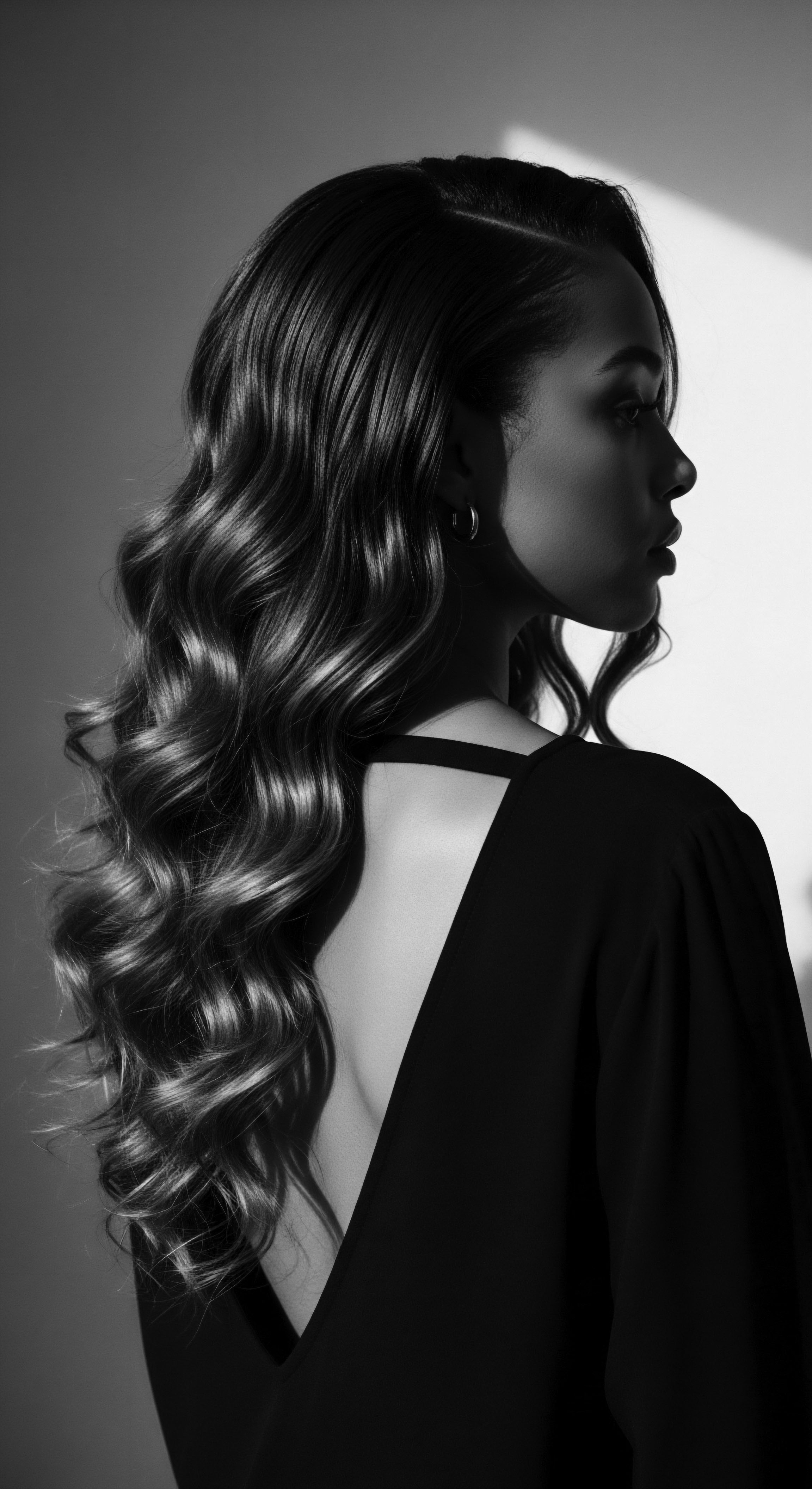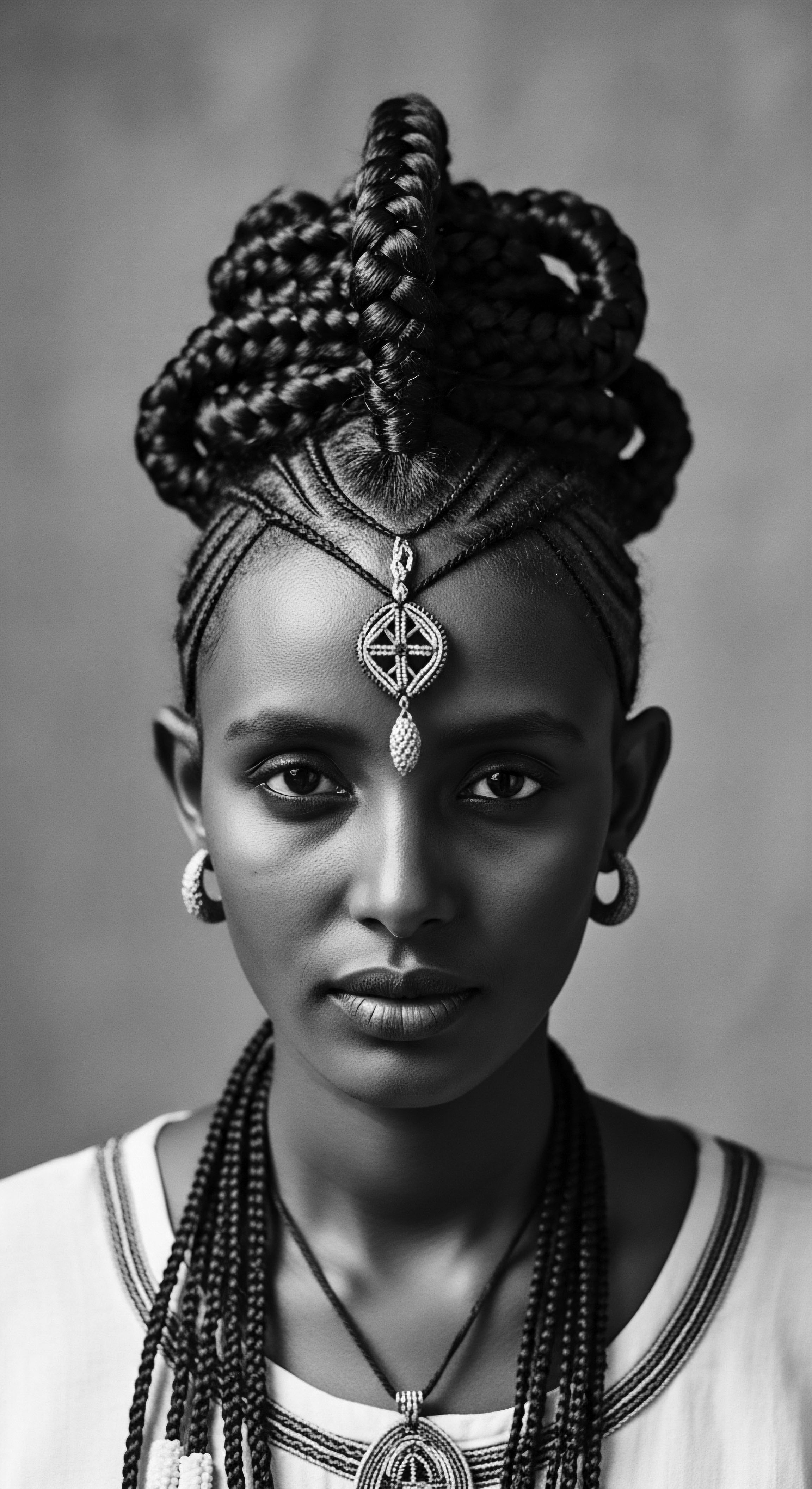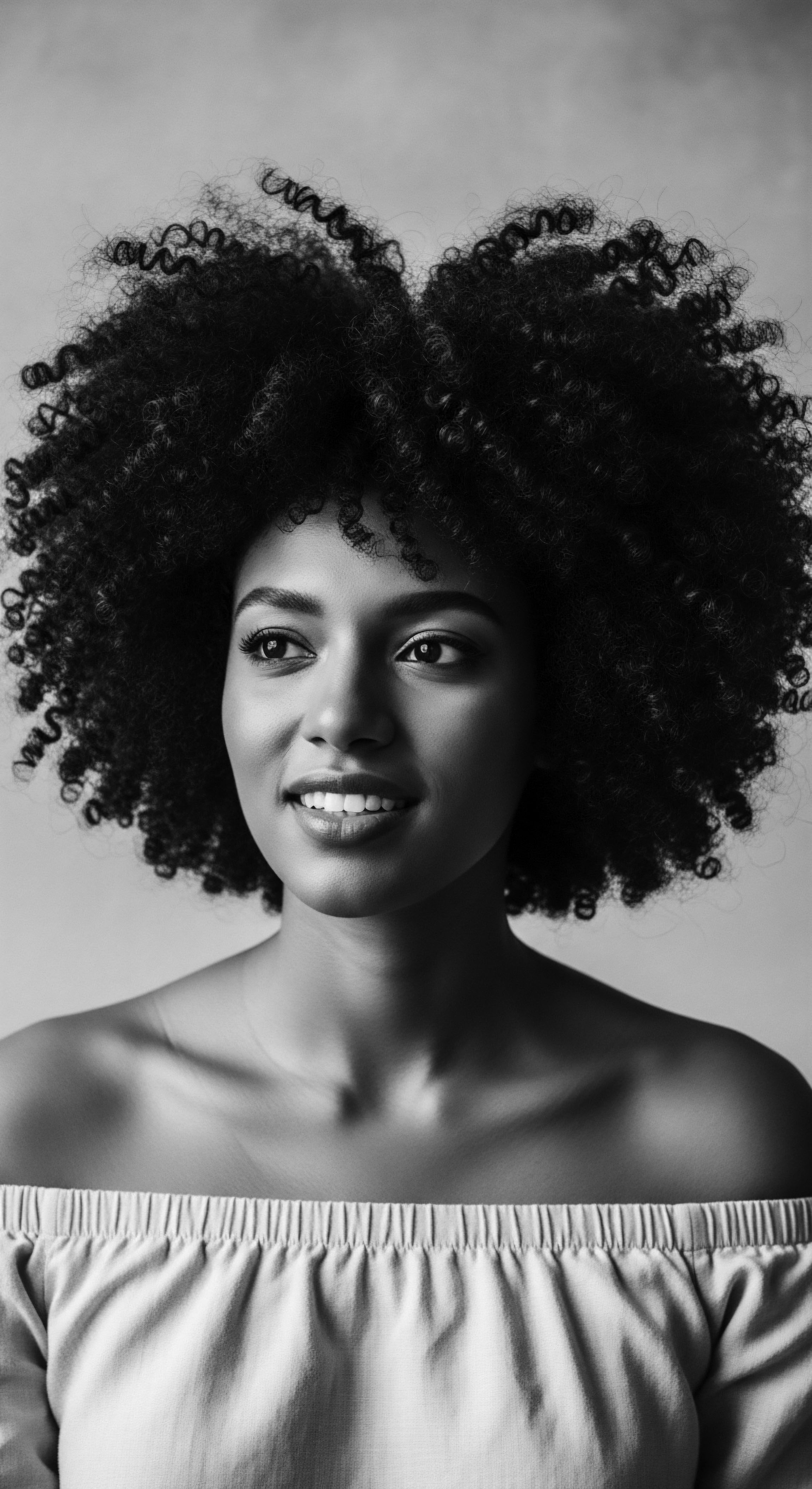
Roots
Consider the deep, resonant rhythm of a story passed down through generations, not in hurried whispers, but in the deliberate, grounding touch of hands upon hair. This is how we begin to comprehend the inherent wisdom within a substance like shea butter, its virtues for textured hair not merely discovered, but honored across centuries, a living echo of ancestral care. From the heart of West Africa, where the magnificent shea tree, known as the Karite Tree or the “tree of life,” graces the savannahs, springs a legacy. This remarkable tree, Vitellaria paradoxa, bestows upon us its precious nuts, from which, through patient, time-honored processes, comes shea butter – a gift that has sustained communities and nurtured strands for millennia.
The scientific understanding we gather today, with its precise terminology and molecular explanations, arrives as a validation, a contemporary language for a knowledge that has long resided in the careful practices of those who came before. When we inquire into the unique scientific properties of shea butter that render it so beneficial for textured hair, we are not simply listing chemical compounds. We are, in truth, listening to the whispered wisdom of grandmothers, observing the communal rituals of village life, and recognizing the profound connection between the earth’s offerings and the very fabric of identity. The efficacy of shea butter, particularly for the unique architecture of textured hair, lies deeply entwined with its natural composition, a composition that has been intuitively understood and applied for generations.

The Shea Tree’s Ancestry and Its Nourishing Yield
The journey of shea butter, often called “women’s Gold,” begins with the diligent hand-harvesting of its nuts, a practice predominantly carried out by women across the Sudano-Sahelian Belt. This ancient tradition speaks volumes about communal livelihood and sustainable interaction with the natural world. The laborious extraction involves crushing, roasting, and boiling the nuts to release their rich oil, which then cools into the distinct butter. This traditional method, sustained for centuries, ensures the retention of shea butter’s potent properties, making it a cornerstone of not only hair and skin care but also culinary and medicinal practices in its native lands.
Records of shea butter’s importance extend far back, with evidence suggesting its use even in ancient Egyptian trade, transporting this vegetable oil along caravan routes thousands of years ago (Gallagher et al. 2023).

Decoding Shea’s Chemistry for Textured Hair
The intrinsic value of shea butter for textured hair stems from its remarkable chemical makeup. It is a complex blend, primarily composed of triglycerides, which form the buttery, solid structure at room temperature. Yet, its distinctiveness, its true power, resides in its significant proportion of Unsaponifiable Matter. This non-glyceride fraction, notably higher than in many other vegetable oils, retains the most active ingredients, substances that do not convert into soap during processing and hold profound benefits for hair and scalp alike.
The fatty acid profile of shea butter is particularly well-suited for the inherent needs of coiled, curled, and wavy strands. These fatty acids include:
- Oleic Acid (Omega-9) ❉ Often comprising 40-50% of its content, this monounsaturated fatty acid closely mirrors the lipids naturally found in sebum, the scalp’s own protective oil. It aids in deep penetration and moisture retention, allowing hydration to truly permeate the hair shaft.
- Stearic Acid ❉ Present in high concentrations (36-50%), this saturated fatty acid contributes to shea butter’s solid texture and its ability to form a protective, emollient film on the hair surface, sealing moisture within.
- Linoleic Acid (Omega-6) ❉ An essential fatty acid, meaning the body cannot produce it, linoleic acid helps fortify the hair’s natural barrier, preventing moisture loss and contributing to strand strength. It may also play a role in supporting hair growth and scalp health.
- Palmitic Acid ❉ This saturated fatty acid further contributes to the emollient properties, softening the hair and enhancing its pliability.
The combined action of these fatty acids provides a potent moisturizing effect, allowing shea butter to absorb effectively into the hair fiber without a greasy residue, forming a thin, protective film that safeguards hydration. This characteristic is especially valuable for textured hair, which, due to its unique helical structure, makes it more challenging for natural scalp oils to travel down the entire strand, leading to increased dryness and susceptibility to breakage.
Shea butter’s rich composition of fatty acids and unsaponifiable matter forms a formidable shield, deeply hydrating textured hair and preserving its delicate moisture balance.

What Specific Vitamins Contribute to Shea’s Hair Benefits?
Beyond its fatty acids, shea butter is a natural reservoir of vitamins, each playing a vital role in hair and scalp vitality. These compounds speak to a holistic approach to hair care, a perspective deeply rooted in ancestral practices that valued overall wellness.
Vitamin A helps support cell reproduction, contributing to the healthy functioning of hair follicles and stimulating the production of natural sebum, which provides inherent protection for the hair shaft. Vitamin E, a powerful antioxidant, helps reduce oxidative stress on the scalp, which can compromise hair health. It combats free radicals and helps maintain a healthy environment for hair growth. Furthermore, shea butter contains Vitamin F, a term often used to collectively describe essential fatty acids like linoleic acid.
This helps maintain moisture balance and contributes to a healthy scalp. These vitamins work in concert, offering a comprehensive nourishment that goes beyond superficial conditioning, echoing the deep, foundational care provided by generations.

Ritual
The tender act of hair care, particularly within communities of textured hair, has always been more than a mere routine. It is a Sacred Ritual, a quiet dialogue between the hands that nurture and the strands that tell stories of lineage and identity. Shea butter, often at the heart of these traditions, became a tangible expression of care, its properties instinctively understood and applied through generations of hands-on experience. The wisdom of its use, long before modern scientific laboratories could analyze its compounds, stemmed from empirical observation and a profound connection to the natural world.

A Legacy of Protection and Deep Hydration
Ancestral practices often emphasized the need for protection against the elements, and textured hair, with its unique structural characteristics, was particularly susceptible to dryness and breakage. Shea butter, a solid yet pliable substance, naturally became a cornerstone for sealing in precious moisture. Its ability to form a protective coating around each strand helps prevent the rapid evaporation of water, a persistent challenge for coily and curly hair where natural sebum struggles to travel down the entire length of the helical shaft. This protective barrier also offered a shield against environmental stressors, from harsh sun and drying winds to dust, safeguarding the hair from damage.
The traditional method of melting a small portion of raw shea butter between the palms, warming it with body heat, and then carefully working it through the hair, allowed for an even distribution that maximized its emollient and occlusive effects. This approach ensured that the hair was not merely coated, but truly permeated with the butter’s beneficial compounds, leading to softer, more pliable, and resilient strands. This deep conditioning was not a luxury; it was a daily necessity, a preventative measure to preserve the health and vitality of textured hair in challenging climates.

What Ancient Practices Highlight Shea’s Protective Powers for Textured Hair?
Across diverse communities in West Africa, the application of shea butter for hair protection was interwoven with daily life and significant ceremonies. Women would often apply shea butter before styling, braiding, or twisting hair, creating a slippery surface that reduced friction and minimized breakage. This proactive conditioning contributed to the longevity of protective styles and the overall strength of the hair.
Moreover, in many traditions, shea butter served as a sealant after cleansing with natural herbs, locking in the water absorbed during the washing process. This layered approach to hydration underscores an intuitive understanding of the hair’s need for both moisture and a mechanism to retain it.
The time-honored application of shea butter is a testament to generations who instinctively understood its powerful emollient and protective qualities for textured hair.
Consider the historical usage of shea butter in Ghana, where it was not only a commodity for trade but also a fundamental ingredient in daily beauty rituals. In these contexts, women would apply shea butter to their children’s hair, especially infants, as a means of protection and softening. This familial transfer of knowledge, from mother to child, solidified shea butter’s role as a staple in textured hair care from the earliest stages of life. Such practices illustrate a holistic view of well-being where healthy hair signified strength, beauty, and cultural continuity.

Soothing the Scalp, Preserving Its Balance
The benefits of shea butter extend beyond the hair strands to the scalp, a vital foundation for healthy growth. Traditional healers and caregivers recognized shea butter’s soothing qualities for irritated or dry scalps, often caused by environmental factors or harsh cleansing agents. Modern science now explains this through the presence of specific compounds within shea butter, such as Triterpenes and Amyrin. These natural plant-derived compounds possess well-documented anti-inflammatory properties.
When massaged into the scalp, shea butter can help reduce redness, relieve itching, and alleviate flaking, thereby supporting a balanced and healthy scalp environment. This restorative action mirrors ancestral remedies for various skin and scalp discomforts, where natural ingredients were sought for their healing attributes.
The application as a balm, often after traditional hair washing with natural saponins from plants, allowed the scalp to rehydrate and find equilibrium. This contrasts sharply with some modern practices that might strip the scalp of its natural oils, leading to irritation. Shea butter offered a gentle, restorative touch, respecting the body’s inherent mechanisms of health.
| Aspect of Use Purpose |
| Traditional Application (Heritage) Protection from elements, ritualistic care, communal bonding, symbolic significance, deep conditioning. |
| Contemporary Application (Modern Science) Moisture sealing, frizz reduction, damage repair, scalp health improvement, heat protection. |
| Aspect of Use Method |
| Traditional Application (Heritage) Warmed between palms, manually worked into damp hair after cleansing with natural ingredients, applied before styling or braiding. |
| Contemporary Application (Modern Science) Used as a leave-in conditioner, styling balm, pre-poo treatment, ingredient in commercial products. |
| Aspect of Use Frequency |
| Traditional Application (Heritage) Often daily or as part of regular grooming rituals, especially for children. |
| Contemporary Application (Modern Science) As needed, often several times a week or as part of a structured regimen. |
| Aspect of Use The enduring presence of shea butter in textured hair care reflects a continuous dialogue between ancient wisdom and scientific understanding. |

Relay
The story of shea butter’s journey through time and across continents is a compelling relay race, where ancestral wisdom passes the baton to modern scientific inquiry. This continuity illuminates how properties observed for millennia now find their precise explanations in biochemistry, strengthening the profound heritage of textured hair care. Shea butter represents not merely an ingredient, but a living archive of resilience and adaptation, its benefits for textured hair validated anew with every study and every application.

The Enduring Legacy in Hair Science
Scientific research continues to dissect the complex profile of shea butter, confirming what generations have intuitively known. The high concentration of fatty acids, particularly oleic and stearic acids, contributes significantly to its emollient properties, allowing it to penetrate the hair shaft and create a protective film. This film prevents moisture loss, a fundamental challenge for the unique architecture of textured hair, which has a naturally raised cuticle and often fewer lipid layers compared to straight hair. This protective function is crucial for preventing dryness and subsequent breakage, common concerns for many with coily or curly hair.
Beyond moisture, the unsaponifiable fraction of shea butter, that small but mighty percentage of compounds that are not converted into soap during processing, holds significant value. This fraction contains triterpenes, sterols, and hydrocarbons, which are responsible for many of shea butter’s restorative and anti-inflammatory properties. These compounds are especially beneficial for scalp health, calming irritation and supporting a balanced microbiome, which is essential for healthy hair growth. A study found that shea butter helps the skin react less to irritants, which researchers attribute to the compound Amyrin, known for its anti-inflammatory effects (Healthline, 2018).

Can Modern Biochemistry Fully Explain Shea’s Long-Held Efficacy for Textured Hair?
While modern biochemistry can articulate the molecular mechanisms behind shea butter’s benefits, it still builds upon a foundation of ancestral understanding. The scientific validation of its moisturizing and anti-inflammatory properties, for instance, provides a deeper lens through which to appreciate why this butter was so consistently used in traditional hair care. For textured hair, which is prone to dryness and often experiences a more delicate cuticle, shea butter’s ability to soften strands and improve manageability is a direct result of its lipid profile and its interaction with the hair’s external layer.
The rich supply of Vitamins A, E, and F contributes to the overall health and resilience of hair. Vitamin A supports cell regeneration and sebum production, forming a natural protective layer. Vitamin E, as an antioxidant, safeguards hair follicles from environmental aggressors and oxidative stress. This combined nutritional delivery helps maintain hair strength and elasticity, reducing susceptibility to breakage, particularly for textured hair that can be more fragile due to its coily structure.
The enduring legacy of shea butter in textured hair care bridges ancient wisdom and modern scientific understanding, revealing a profound natural synergy.

Collagen, Keratin, and Strand Fortification
A fascinating aspect of shea butter’s scientific properties lies in its potential to support the structural integrity of hair. Research indicates that certain compounds within shea butter, such as triterpenes, may aid in boosting collagen production. Collagen, a crucial protein, is linked to the overall health and elasticity of the skin, including the scalp, which in turn influences hair growth and resilience.
Moreover, the presence of certain nutrients can strengthen Keratin, the primary protein that makes up hair. By supporting these fundamental building blocks, shea butter contributes to hair that is less prone to breakage and appears more robust, especially for textured strands that often experience dryness and brittleness.
The ability of shea butter to penetrate the hair shaft, rather than simply sitting on the surface, allows its beneficial components to work from within, helping to repair and protect the hair’s natural lipid barrier. This restoration process can significantly reduce split ends and breakage, leading to healthier, more vibrant hair over time. The historical application of shea butter as a restorative balm after periods of environmental stress or intensive styling speaks to this inherent strengthening quality.

The Uniqueness of Unsaponifiables in Hair Health
The percentage of Unsaponifiable Matter in shea butter, which can be as high as 10% (whereas most other vegetable oils have around 1%), truly sets it apart. This fraction contains a complex mix of compounds that do not turn into soap when saponified, including phytosterols, triterpene alcohols, and hydrocarbons. These are the biologically active compounds that contribute to its healing, soothing, and protective effects. The presence of these unsaponifiables makes shea butter a potent ingredient for topical applications, offering benefits that extend beyond simple moisturization.
They provide antioxidant properties, help reduce inflammation on the scalp, and support the skin’s barrier function, all critical for maintaining textured hair health from the roots upwards. This unique composition is a key reason for shea butter’s long-standing efficacy in traditional hair care.
| Chemical Component Oleic Acid (Omega-9) |
| Hair Benefit for Textured Hair Deep hydration, improved moisture penetration, natural sebum mimicry. |
| Chemical Component Stearic Acid |
| Hair Benefit for Textured Hair Forms protective barrier, locks in moisture, enhances film-forming properties. |
| Chemical Component Linoleic Acid (Omega-6) |
| Hair Benefit for Textured Hair Strengthens hair's natural barrier, reduces moisture loss, supports scalp health. |
| Chemical Component Vitamins A & E |
| Hair Benefit for Textured Hair Antioxidant protection, cell regeneration, healthy scalp environment, sebum stimulation. |
| Chemical Component Triterpenes/Amyrin |
| Hair Benefit for Textured Hair Anti-inflammatory, soothes scalp irritation, reduces flaking and redness. |
| Chemical Component Unsaponifiable Matter |
| Hair Benefit for Textured Hair Rich in bioactive compounds, enhances overall healing, protective, and conditioning effects. |
| Chemical Component The synergistic action of these components underpins shea butter's revered status in textured hair care heritage. |
The economic and social heritage of shea butter production provides a powerful lens through which to understand its value. The shea butter industry, deeply rooted in traditional practices, provides livelihood for millions of women across Africa, earning it the designation “women’s Gold.” For instance, in Ghana, the trade of shea nuts and butter has been significant for centuries, with women traditionally managing the collection and processing. Prior to the colonial era, shea butter was traded as far south as the Volta River for coastal and forest products, a testament to its widespread utility and value in the trans-Saharan trade networks (Lewicki, 1974; Cowley, 1928, as cited in Terpend, 1982). This historical context underscores not only the intrinsic properties of shea butter but also its profound cultural and economic significance, a legacy that continues to shape its relevance in textured hair care today.

Reflection
The journey through shea butter’s scientific properties, intertwined with the rich tapestry of textured hair heritage, ultimately leads us to a space of deep appreciation. It is a space where the wisdom of ancestral practices, refined over countless seasons, aligns with the meticulous precision of modern science. Shea butter, a humble yield from the earth, stands as a quiet yet powerful testament to the ingenuity and resilience of Black and mixed-race communities. Its enduring presence in textured hair care is not merely about its fatty acids or its unsaponifiable matter, potent as they are.
It is about the tender touch of hands that have honored these strands for generations, the communal spirit that thrives around its harvest, and the profound stories of identity and self-acceptance that each curl and coil carries. The soul of a strand, indeed, finds a true ally in the golden balm of shea, whispering tales of continuity and the timeless artistry of care.

References
- Cowley, J. (1928). The Shea-Nut Tree ❉ Its Products and Economic Importance. John Murray.
- Gallagher, J. et al. (2023). The Archaeology of Shea Butter (Vitellaria paradoxa) in Burkina Faso, West Africa. Journal of African Archaeology.
- Healthline. (2018). Shea Butter for Hair ❉ Raw, Hair Growth, and Natural Hair.
- Lewicki, T. (1974). West African Food in the Middle Ages ❉ According to Arabic Sources. Cambridge University Press.
- Terpend, N. (1982). The Shea Tree (Butyrospermum parkii Kotschy) and its Products in West Africa ❉ A Historical and Economic Review.
